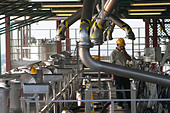Press release
BKWine makes ”World’s Top Wine Tours” according to Travel and Leisure Magazine
Paris, August 23, 2010
BKWine has just been singled out as one of the world’s best wine tour organisers by TravelAndLeisure.com (T+L). In their latest web feature T+L lists the “World’s Top Wine Tours” and BKWine is one of a handful of travel operators selected by Travel and Leisure. T+L singles out BKWine as the tour operator who is best for the traveller who wants to meet the winemakers and who wants to have a personal and unique experience. The full feature can be read here: http://www.travelandleisure.com/articles/worlds-top-wine-tours/3. TravelAndLeisure.com is the internet version of the American travel magazine Travel and Leisure Magazine with around 4.5 million readers.
Britt Karlsson, founder of BKWine, comments: “We were very excited, happy and honoured when we heard that we had been selected by Travel and Leisure. What T+L says also underlines the things that we work hard to achieve: that our travellers should get a very personal and unique experience. I personally visit some 200 different wineries and winemakers every year so I know where the visits will be exceptional. And in a way, it makes me especially proud that an American travel magazine has selected us, a Swedish tour organiser, as one of the world leaders on wine tours!”
BKWine is a Paris (France) based Swedish niche tour organiser specialised in wine and food tours. BKWine organises around 30 wine and gastronomy tours each year to destinations in France, Italy, Spain, South Africa, Portugal and other wine regions. The wine tours are designed both for the enjoyment of individual wine lovers and wine enthusiasts, as well as for professional training and corporate events. All tours are led by BKWine’s wine experts and take the traveller “behind the scene” of the vineyards.
More information on the wine tours: http://www.bkwine.com/wine_tours/wine_tours.htm
---
More information:
- About BKWine: http://www.bkwine.com/international/about_bkwine.htm
- Press photos: http://www.bkwine.com/diverse/press.htm (Additional press photos from our 20.000 picture library are available on request)
Press contacts:
- Britt Karlsson, ph 00 33 6 80 45 35 70,
- Per Karlsson, ph 00 33 6 83 51 12 53,
Press photos are available. Please contact us.
About BKWine AB:
51, rue du Chevalier de la Barre, F-92130 Issy-les-Moulineaux (Paris), France, + 33 6 80 45 35 70, http://www.bkwine.com
BKWine AB is run by Britt and Per Karlsson and has four main activities:
- Wine & food tours
- Wine journalism
- Wine photography, wine stock image library: http://www.bkwinephotography.com
- Wine consulting
BKWine was founded in the 90s by Britt Karlsson, a Swede living in Paris. In the early ‘00s she was joined by her husband Per Karlsson in the business that now encompasses several different wine related activates. The main business is organising wine tours for wine enthusiasts and wine professionals who want to visit wine regions to learn more about wine. Each year BKWine organises some 30 wine tours. BKWine also publishes an online newsletter on wine, The BKWine Brief, which reaches some 20,000 subscribers. Britt and Per are members of the British Circle of Wine Writers (CWW), the International Wine Writers Federation (FIJEV), the French Wine Press Association (APV), the International Wine and Food Society (IWFS) and several other wine and gastronomic organisations.
Read more...
 You can go to the Greek peninsula of Halkidiki just to enjoy the fabulous nature but you can also to there to taste the fabulous wines of Evangelos Gerovassiliou on his estate, just 20 minutes away from the busy city of Thessaloniki. And after the city, this feels like paradise. You will enjoy the view of the glittering blue sea and if you’re lucky you will see all the way to Mount Olympus, famous hang-out for the ancient gods. Evangelos Gerovassiliou was one of the persons responsibly for the rebirth of the Greek wine some 25 years ago, when he was working as a winemaker at the Bordeaux inspired domaine Porto Carras. Now he has his own vineyard and he makes wines from Greek grapes as well as from French and other more international varieties. I am especially fond of his “Greek” wines, full of character and made with grapes like the white assyrtiko or the red limnio. A favourite is the white Malagousia, a powerful and very tasty wine with aromas of lemon, honey, lavender and other fresh herbs and flowers.
You can go to the Greek peninsula of Halkidiki just to enjoy the fabulous nature but you can also to there to taste the fabulous wines of Evangelos Gerovassiliou on his estate, just 20 minutes away from the busy city of Thessaloniki. And after the city, this feels like paradise. You will enjoy the view of the glittering blue sea and if you’re lucky you will see all the way to Mount Olympus, famous hang-out for the ancient gods. Evangelos Gerovassiliou was one of the persons responsibly for the rebirth of the Greek wine some 25 years ago, when he was working as a winemaker at the Bordeaux inspired domaine Porto Carras. Now he has his own vineyard and he makes wines from Greek grapes as well as from French and other more international varieties. I am especially fond of his “Greek” wines, full of character and made with grapes like the white assyrtiko or the red limnio. A favourite is the white Malagousia, a powerful and very tasty wine with aromas of lemon, honey, lavender and other fresh herbs and flowers.



















































